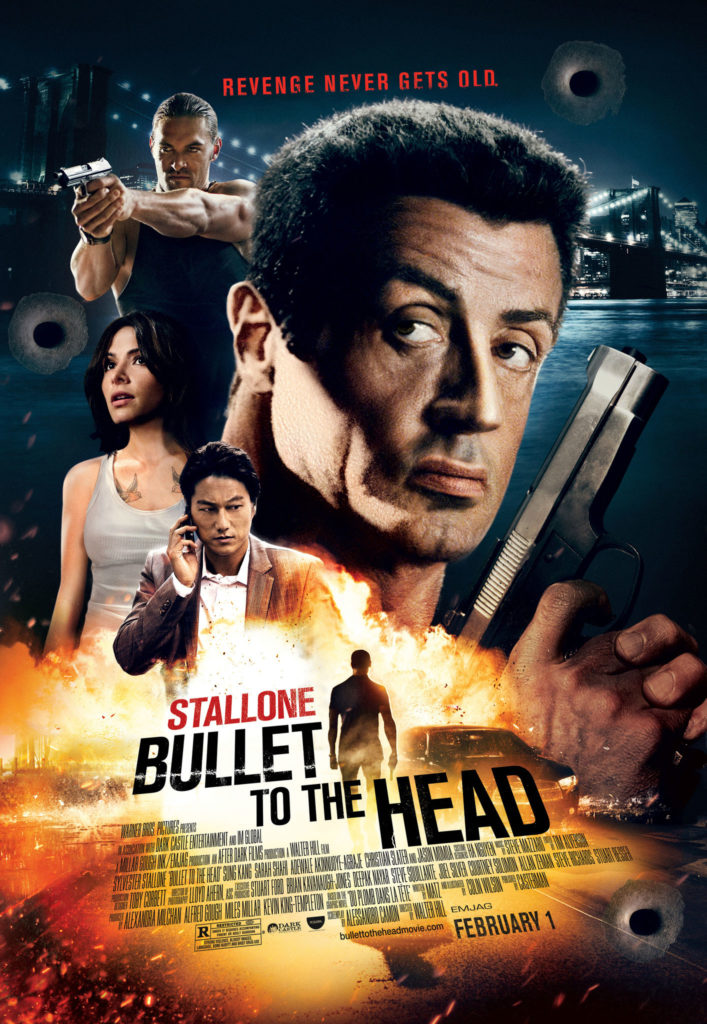If there is one positive from Hurricane Katrina, one not worth the cost yet still a positive, it has been the emergence of a Louisiana style of crime filmmaking — a bayou noir. Filmmakers have been drawn to the state in a show of solidarity with the residents of Louisiana and to take advantage of tax credits. It’s a win-win for the film industry and for local economies. Whether or not it’s a win for audiences rests on whether or not these films are worth watching.
Bullet to the Head, from 2012, is an adaptation of the graphic novel Du Plomb Dans La Tête by Matz and Colin Wilson. Walter Hill directed from a screenplay by Alessandro Camon. Sylvester Stallone stars as James ‘Bobo’ Bonomo, a professional hitman who, like all professional hitmen in movies, ends up on the receiving end of a double-cross. There are no producing or writing credits for Sly in this one. He’s here to appear on screen only.
Bobo and his partner, Louis (John Seda), take out a corrupt former cop from Washington, D.C. named Hank Greely (Holt McCallany). After the job is done, Bobo and Louis are betrayed, and Louis is killed. Meanwhile, Taylor Kwon (Sung Kang), Greely’s former partner, is on Greely’s trail in an effort to bring him to justice. Circumstances take some illogic twists and turns, resulting in Bobo and Kwon partnering up to find and take down the people that ordered the hit on Greely.
Those responsible are Adewale Akinnuoye-Agbaje as New Orleans crime boss Robert Morel, Christian Slater as shady lawyer Marcus Baptiste, and Jason Momoa as the lethal and  psychotic Keegan, who is Sly’s foe in violence in this film.
psychotic Keegan, who is Sly’s foe in violence in this film.
Bobo and Kwon must cut a swath through the underworld to get to Morel. Along the way there are gunfights and interrogations, and plenty of arguments between Bobo and Kwon about the best way to proceed. Boy, are there arguments.
Bullet to the Head follows a similar template to films such as 48 Hours, Lethal Weapon, or any other where two characters partner up against well-armed criminals. Audiences might not think about it much, but the interplay between the two leads in films like this is very important to their success. Action in film has been honed to a fine art by decades of Hollywood experimentation. It almost films itself by this point. It’s in the scenes between the action where a film like Bullet to the Head succeeds or fails, and most of that comes down to the leads.
In this film, Sly is the weary elder, the tough guy with the thousand-yard stare and growling impatience. Kang is the upstart who gets on the older guy’s nerves. This formula worked well in 48 Hours (also helmed by Hill), where the roles of cop and criminal were reversed. But, unlike in 48 Hours, where Nick Nolte and Eddie Murphy chewed up every scene they had together, Sly and Kang are never able to establish the same chemistry. Most of the time a viewer spends with these two is needlessly tense. Kang’s character keeps saying things that annoy Bobo, and Sly’s task is to just get annoyed and then berate Kang. It’s uncomfortable. It’s supposed to foreshadow a growing sense of camaraderie between the two but it just feels like needlessly harsh criticism on Bobo’s part. As for Kang, both he and his character wither in the presence of Sly Stallone. Sly owns every scene he’s in, leaving little room for an actor like Kang, who appeared too timid to seize his opportunities.
Overall, the performances in the film are mediocre. Kwon was miscast, and Momoa’s face is frozen in a Novocaine rictus. But this is an above-average performance from Sly. He seemed to be into this film. He also exercised the Rocky clause in his contract, whereby there must be a grand finale bout of single combat between Sly and baddest bad guy in the flick — in this case, Momoa. They fight each other using fire axes. Badass.
Walter Hill is not the same director from his younger days. But there is still plenty of life to this film. It wanders close to being a generic thriller, but then a viewer notices that care was put into the film. The soundtrack isn’t the synthesized filler that I hate so much about the Expendables films. The cinematography is atmospheric. The pacing is quite good. These are the things that work well. But the things in this film that don’t work well, particularly some of the casting and some of the dialogue, are enough to drag the overall quality of the film down to the point where it’s forgettable.
